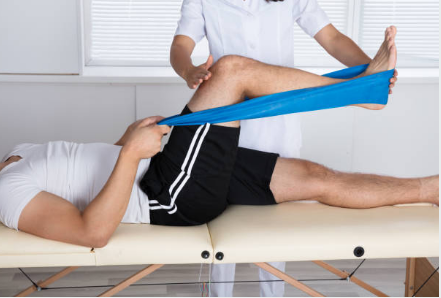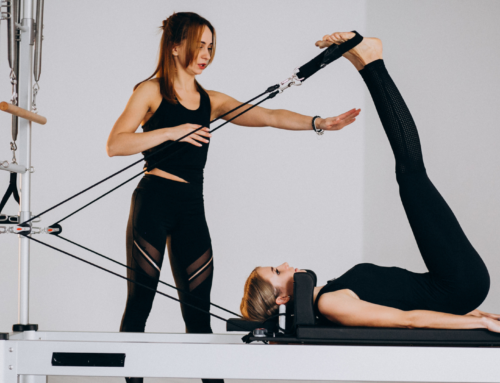Knee osteoarthritis (OA) is a common and debilitating condition that affects millions of people worldwide. It involves the gradual degradation of the cartilage (which is the cushioning in between the bones) in the knee joint, leading to pain, stiffness, and reduced mobility. As the population ages, the prevalence of knee osteoarthritis is expected to rise, making it crucial to understand the condition and its treatment options. Among the various treatment modalities, physiotherapy stands out as a cornerstone in managing knee osteoarthritis. This blog post explores the causes, symptoms, and physiotherapy treatments for knee osteoarthritis, highlighting its importance in improving patients’ quality of life.
Causes of Knee Osteoarthritis
Knee osteoarthritis results from a combination of factors, including:
- Aging:
- The risk of developing knee osteoarthritis increases with age as the cartilage becomes more brittle and less resilient over time.
- Obesity:
- Excess body weight places additional stress on the knee joints, accelerating cartilage wear and tear.
- Joint Injury:
- Previous knee injuries, such as ligament tears or fractures, can lead to osteoarthritis later in life.
- Repetitive Stress:
- Jobs or activities that involve repetitive knee movements or heavy lifting can contribute to joint damage.
- Muscle Weakness:
- Weakness in the muscles surrounding the knee can lead to joint instability and increased stress on the cartilage.
- Inflammation:
- Chronic inflammation in the knee joint can damage the cartilage and contribute to osteoarthritis.
- Gender:
- Women are more likely to develop knee osteoarthritis than men, especially after menopause, due to hormonal changes that affect joint health.
Symptoms of Knee Osteoarthritis

The symptoms of knee osteoarthritis can vary in severity and often worsen over time. Common symptoms include:
- Pain:
- Persistent pain in the knee, especially during or after movement, is the most common symptom. The pain can range from mild to severe.
- Stiffness:
- Stiffness in the knee, particularly in the morning or after periods of inactivity, is a hallmark of osteoarthritis.
- Swelling:
- Inflammation and fluid accumulation can cause the knee to swell.
- Decreased Range of Motion:
- Reduced flexibility and difficulty fully straightening or bending the knee.
- Grinding Sensation:
- A sensation of grinding or crunching (crepitus) in the knee joint during movement.
- Weakness:
- Muscle weakness around the knee, leading to instability and difficulty performing daily activities.
- Deformity:
- In advanced cases, knee osteoarthritis can cause visible changes in the shape of the knee joint.
Role of Physiotherapy in Treating Knee Osteoarthritis

Physiotherapy plays a vital role in the management of knee osteoarthritis. It focuses on reducing pain, improving joint function, and enhancing the overall quality of life. Here’s how physiotherapy can help:
- Pain Management:
- Manual Therapy: Techniques such as joint mobilization and soft tissue massage can help reduce pain and improve joint mobility.
- Modalities: The use of heat, ice, ultrasound, and electrical stimulation can alleviate pain and reduce inflammation.
- Improving Range of Motion:
- Stretching Exercises: Gentle stretching exercises can enhance flexibility and reduce stiffness in the knee joint.
- Joint Mobilization: Specific techniques to improve joint mobility and reduce restrictions.
- Strengthening Muscles:
- Resistance Training: Targeted exercises to strengthen the muscles around the knee, such as the quadriceps, hamstrings, and calf muscles. Strong muscles provide better support and reduce stress on the knee joint.
- Functional Training: Exercises that mimic daily activities to improve overall strength and function.
- Enhancing Balance and Proprioception:
- Balance Exercises: Activities to improve balance and coordination, reducing the risk of falls and further injury.
- Proprioceptive Training: Exercises that enhance the body’s ability to sense joint position, improving stability.
- Improving Joint Function:
- Gait Training: Analysis and correction of walking patterns to reduce stress on the knee and improve efficiency.
- Assistive Devices: Recommendations for the use of braces, orthotics, or walking aids to support the knee and enhance mobility.
- Education and Self-Management:
- Patient Education: Teaching patients about their condition, proper body mechanics, and strategies to manage symptoms effectively.
- Lifestyle Modifications: Guidance on weight management, activity modification, and ergonomic adjustments to reduce stress on the knee.
- Individualized Treatment Plans:
- Physiotherapists create personalized treatment plans based on the patient’s specific needs, goals, and severity of osteoarthritis. This tailored approach ensures optimal outcomes.
Benefits of Physiotherapy for Knee Osteoarthritis

-
- The benefits of physiotherapy in managing knee osteoarthritis are numerous:
- Pain Relief:
- Physiotherapy interventions help reduce pain and improve the ability to perform daily activities without discomfort.
- Improved Function:
- By enhancing strength, flexibility, and joint mobility, physiotherapy improves overall knee function and quality of life.
- Delay in Surgery:
- Effective physiotherapy management can delay or even prevent the need for surgical intervention.
- Enhanced Mobility:
- Patients experience improved mobility and independence, allowing them to participate in daily activities and recreational pursuits.
- Prevention of Further Damage:
- Strengthening and stabilizing the knee joint can prevent further cartilage damage and slow the progression of osteoarthritis.
- Empowerment:
- Education and self-management strategies empower patients to take control of their condition and maintain an active lifestyle.
rest periods to prevent injuries.
- Pain Relief:
- The benefits of physiotherapy in managing knee osteoarthritis are numerous:






